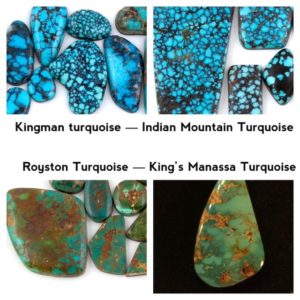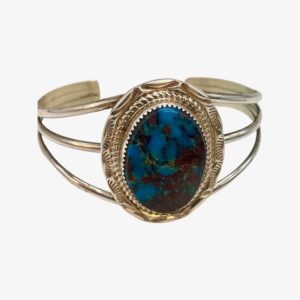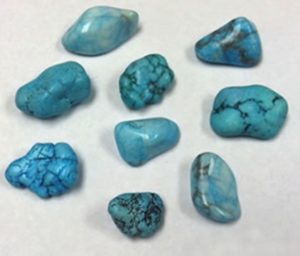Many shoppers search online for turquoise from mines they associate with a specific color or pattern. For instance, the Sleeping Beauty mine is most known for its clear sky blue stones and King’s Manassa mine is famous for brilliant greens and golden host stone.
But I’ve learned enough about turquoise to be humbled by its complexity. It’s impossible to know which mine a piece of turquoise came from based on sight alone. Sure, you might find more shades of green turquoise with caramel-colored veins in Nevada where geologically there are larger deposits of iron. But there have been more than 100 turquoise mines in Nevada! The webbed dark green turquoise from Nevada’s popular Royston mines can even look like turquoise found at King’s Masassa Mine in Colorado. (And that’s Royston mines plural. There are several mines with different owners in that area.) Royston turquoise can also look like the Nevada Blue Gem and Easter Blue mines, according to Alltribes.com.

Many mines throughout the Southwest produce a variety of similar blue and green shades. A shade of blue and webbing found at the Kingman mine in Arizona may also be found at Indian Mountain mine in Nevada.
At best, with study and experience, you can narrow down a stone’s origin to two of three possible mines or the region. So, unless you buy from the mine, or a reputable maker or dealer, you cannot be certain of the mine from which your beautiful stone originated. With vintage jewelry turquoise, it is particularly difficult, if not impossible.
Why does it matter? It comes down to personal preference, and collectible and search value. For collectors like myself, it’s important that the stone I’m wearing comes from the Southwest I love. Since there are few remaining active turquoise mines in the United States, the rarity is part of the draw.
As for collectible value, that’s based on quality, supply, and demand.
Only 5 percent of turquoise mined worldwide is hard enough for jewelry making. Most jewelry turquoise has been enhanced and/or stabilized or reconstituted from powdered stone. Some mines – Lone Mountain and Pilot Mountain for instance – are noted for having higher quality stones that are harder and of lasting vivid color that do not require treatment. So, generally turquoise from those mines and a few others is more valuable.

A few mines are also noted for small deposits and rare colors. Lander Blue, famous for its dark blue color, comes from what’s referred to as a “hat mine” – a deposit so small the surface of the mine can be covered with a hat. Like all things in commerce, there’s also some hype and trends involved. Lander Blue has been highly-marketed which has made it one of the most expensive.
Which brings up a key note: Most “turquoise” sold in department stores isn’t turquoise, but dyed stone, most likely dyed Howlite which is white with black matrix in nature. There are several other blue-green stones that look similar to turquoise and commonly given false turquoise names including but not limited to: Odontolite, (fossil turquoise); Smithsonite (Sacred Turquoise); variscite (Utah turquoise); Then there are outright fake stones, resin and even dyed cement.
If it is turquoise that you find in a department store, it’s most likely from an Asian mine. According to Smithsonian magazine, more than 75 percent of turquoise sold today is from China. Some has even been given a Native American-sounding name “Cloud Mountain.” As stocks of American turquoise become more scarce, even some Native American jewelers are using imported Chinese turquoise.

One of the first indicators of whether the turquoise is U.S. mined is price. True American turquoise jewelry isn’t cheap. The higher the quality – density and clarity – and trend, the higher the cha-ching.
